Performance-based assessments for network analysis competencies
Question 1:
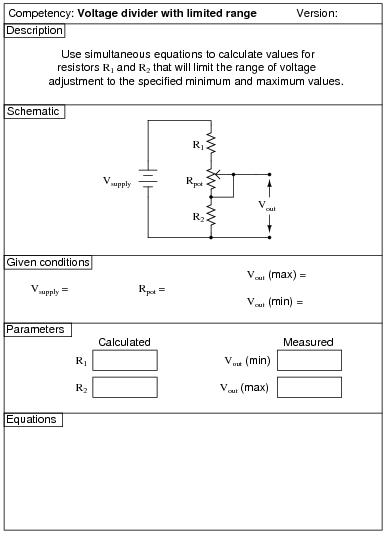
|
|
Notes:
The purpose of this exercise is for students to use simultaneous equations to arrive at values for fixed resistors R1 and R2 that will limit output voltage adjustment to the limits specified.
An extension of this exercise is to incorporate troubleshooting questions. Whether using this exercise as a performance assessment or simply as a concept-building lab, you might want to follow up your students' results by asking them to predict the consequences of certain circuit faults.
Question 2:
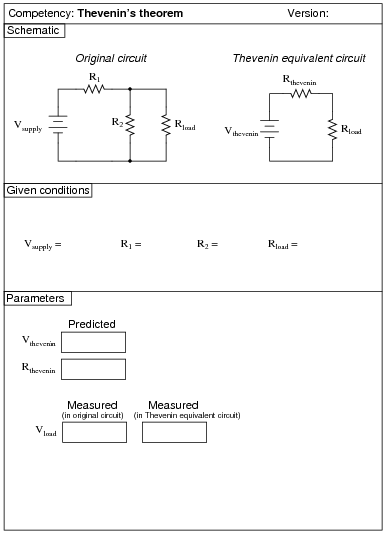
|
|
Notes:
Use a variable-voltage, regulated power supply for Vthevenin, and a fixed-voltage supply for Vsource. Specify standard resistor values, all between 1 kW and 100 kW (1k5, 2k2, 2k7, 3k3, 4k7, 5k1, 6k8, 10k, 22k, 33k, 39k 47k, 68k, etc.) for resistors in the original circuit. A decade box or potentiometer will suffice for Rthevenin.
In case it is not already crystal-clear, I want students to build two different circuits for this exercise: the öriginal" circuit and also a "Thevenin equivalent" circuit, then plug the exact same load resistor into both circuits (one at a time) to see that the voltage across it is the same in both cases. Many students seem to struggle with the basic concept of equivalent circuits, and I have found this exercise (once successfully completed) to be excellent for "making it real" to these students.
An extension of this exercise is to incorporate troubleshooting questions. Whether using this exercise as a performance assessment or simply as a concept-building lab, you might want to follow up your students' results by asking them to predict the consequences of certain circuit faults.
Question 3:
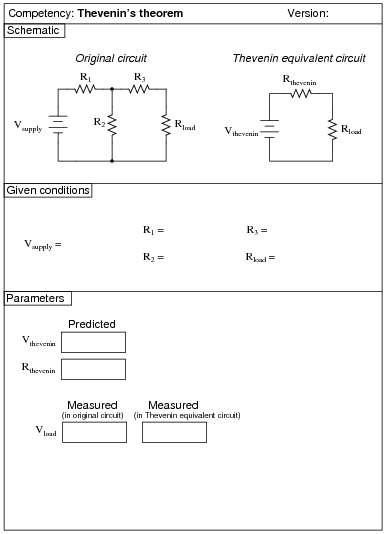
|
|
Notes:
Use a variable-voltage, regulated power supply for Vthevenin, and a fixed-voltage supply for Vsource. Specify standard resistor values, all between 1 kW and 100 kW (1k5, 2k2, 2k7, 3k3, 4k7, 5k1, 6k8, 10k, 22k, 33k, 39k 47k, 68k, etc.) for resistors in the original circuit. A decade box or potentiometer will suffice for Rthevenin.
In case it is not already crystal-clear, I want students to build two different circuits for this exercise: the öriginal" circuit and also a "Thevenin equivalent" circuit, then plug the exact same load resistor into both circuits (one at a time) to see that the voltage across it is the same in both cases. Many students seem to struggle with the basic concept of equivalent circuits, and I have found this exercise (once successfully completed) to be excellent for "making it real" to these students.
An extension of this exercise is to incorporate troubleshooting questions. Whether using this exercise as a performance assessment or simply as a concept-building lab, you might want to follow up your students' results by asking them to predict the consequences of certain circuit faults.
Question 4:
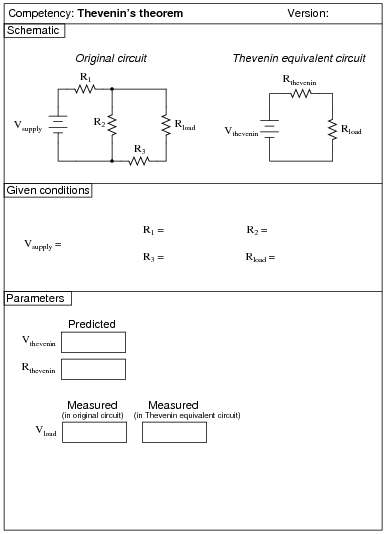
|
|
Notes:
Use a variable-voltage, regulated power supply for Vthevenin, and a fixed-voltage supply for Vsource. Specify standard resistor values, all between 1 kW and 100 kW (1k5, 2k2, 2k7, 3k3, 4k7, 5k1, 6k8, 10k, 22k, 33k, 39k 47k, 68k, etc.) for resistors in the original circuit. A decade box or potentiometer will suffice for Rthevenin.
In case it is not already crystal-clear, I want students to build two different circuits for this exercise: the öriginal" circuit and also a "Thevenin equivalent" circuit, then plug the exact same load resistor into both circuits (one at a time) to see that the voltage across it is the same in both cases. Many students seem to struggle with the basic concept of equivalent circuits, and I have found this exercise (once successfully completed) to be excellent for "making it real" to these students.
An extension of this exercise is to incorporate troubleshooting questions. Whether using this exercise as a performance assessment or simply as a concept-building lab, you might want to follow up your students' results by asking them to predict the consequences of certain circuit faults.
Question 5:
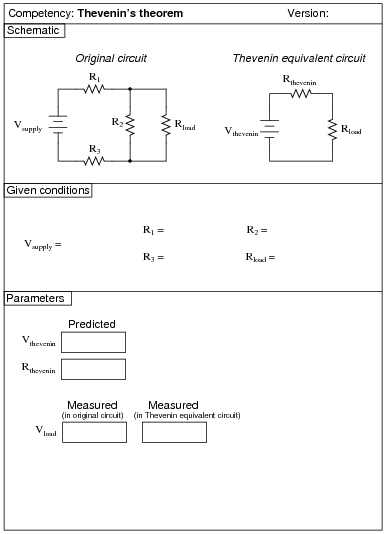
|
|
Notes:
Use a variable-voltage, regulated power supply for Vthevenin, and a fixed-voltage supply for Vsource. Specify standard resistor values, all between 1 kW and 100 kW (1k5, 2k2, 2k7, 3k3, 4k7, 5k1, 6k8, 10k, 22k, 33k, 39k 47k, 68k, etc.) for resistors in the original circuit. A decade box or potentiometer will suffice for Rthevenin.
In case it is not already crystal-clear, I want students to build two different circuits for this exercise: the öriginal" circuit and also a "Thevenin equivalent" circuit, then plug the exact same load resistor into both circuits (one at a time) to see that the voltage across it is the same in both cases. Many students seem to struggle with the basic concept of equivalent circuits, and I have found this exercise (once successfully completed) to be excellent for "making it real" to these students.
An extension of this exercise is to incorporate troubleshooting questions. Whether using this exercise as a performance assessment or simply as a concept-building lab, you might want to follow up your students' results by asking them to predict the consequences of certain circuit faults.
Question 6:
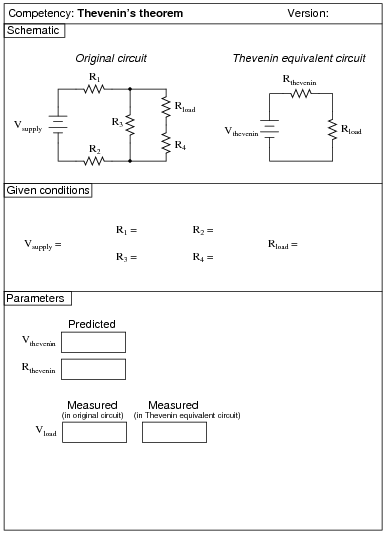
|
|
Notes:
Use a variable-voltage, regulated power supply for Vthevenin, and a fixed-voltage supply for Vsource. Specify standard resistor values, all between 1 kW and 100 kW (1k5, 2k2, 2k7, 3k3, 4k7, 5k1, 6k8, 10k, 22k, 33k, 39k 47k, 68k, etc.) for resistors in the original circuit. A decade box or potentiometer will suffice for Rthevenin.
In case it is not already crystal-clear, I want students to build two different circuits for this exercise: the öriginal" circuit and also a "Thevenin equivalent" circuit, then plug the exact same load resistor into both circuits (one at a time) to see that the voltage across it is the same in both cases. Many students seem to struggle with the basic concept of equivalent circuits, and I have found this exercise (once successfully completed) to be excellent for "making it real" to these students.
An extension of this exercise is to incorporate troubleshooting questions. Whether using this exercise as a performance assessment or simply as a concept-building lab, you might want to follow up your students' results by asking them to predict the consequences of certain circuit faults.
Question 7:
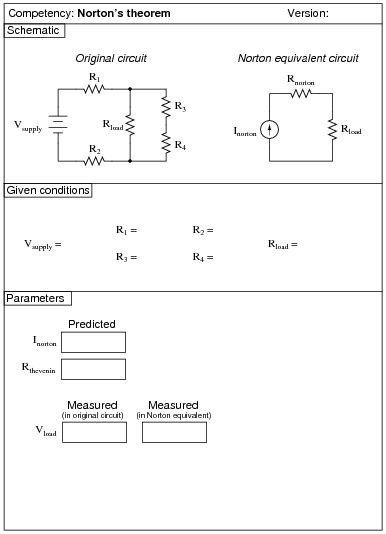
|
|
Notes:
Use a variable-voltage, regulated power supply for Inorton, and a fixed-voltage supply for Vsource. Specify standard resistor values, all between 1 kW and 100 kW (1k5, 2k2, 2k7, 3k3, 4k7, 5k1, 6k8, 10k, 22k, 33k, 39k 47k, 68k, etc.) for resistors in the original circuit. A decade box or potentiometer will suffice for Rnorton.
An extension of this exercise is to incorporate troubleshooting questions. Whether using this exercise as a performance assessment or simply as a concept-building lab, you might want to follow up your students' results by asking them to predict the consequences of certain circuit faults.
